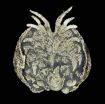(Press-News.org) CAMBRIDGE, MA -- Cancer cells undergo extensive genetic alterations as they grow and spread through the body. Some of these mutations, known as "drivers," help spur cells to grow out of control, while others ("passengers") are merely along for the ride.
MIT cancer biologists at the Koch Institute for Integrative Cancer Research and geneticists from the Broad Institute have now performed the most comprehensive analysis to date of these changes in mice programmed to develop cancer. The team discovered mutations and other genetic disturbances that arise at certain stages of lung cancer development; the researchers were also able to identify tumor cells that broke free to spread to other organs.
The findings, described in the March 13 issue of Cell, suggest possible new targets for drugs for this aggressive form of cancer, known as small cell lung cancer. There are now very few targeted drugs for small cell lung cancer, a highly lethal form of lung cancer that is associated with tobacco use and is usually treated with chemotherapy drugs that have severe side effects.
"Right now, small cell lung cancer is really lagging behind with respect to therapies that target a specific mutation or genetic alteration in the tumors, because we don't know a lot about the drivers in these cancers," says David McFadden, a postdoc at MIT's Koch Institute for Integrative Cancer Research and one of the lead authors of the Cell paper.
Other lead authors of the paper are Koch Institute postdoc Thales Papagiannakopoulos and Broad Institute researchers Amaro Taylor-Weiner, Chip Stewart, and Scott Carter. Senior authors are Tyler Jacks, the David H. Koch Professor of Biology and director of the Koch Institute, and Gad Getz, director of cancer genome computational analysis at the Broad Institute and director of the bioinformatics program at Massachusetts General Hospital.
Tracking cancer progression
The research team studied a strain of mice that lacks two key tumor-suppressor genes, p53 and Rb. These mice develop small cell lung cancer, but scientists don't know exactly how the cancer progresses or which subsequent genetic alterations drive tumor growth.
In studies of human small cell lung cancer, it has been difficult to identify these driver mutations because potent carcinogens in cigarette smoke produce many mutations, most of which don't affect tumor growth. In the mouse model of the disease, fewer mutations arise because the mice are not exposed to cigarette smoke, making it easier to identify the key drivers.
Mice lacking p53 and Rb, the two most commonly mutated tumor suppressors in human small cell lung cancer, develop lung tumors that closely mimic the progression of human small cell lung cancer. These tumors are highly metastatic and usually spread to the lymph nodes near the lungs and then to the liver. The researchers isolated DNA from these tumors and analyzed the genetic alterations that occurred, including genetic mutations as well as changes in the number of copies of a gene or chromosome.
First, the researchers compared genetic alterations that appeared early and late in cancer development. They found that early on, tumors accumulate many extra copies of a gene called Mycl1, a known oncogene that helps cells ignore signals to stop growing. Because Mycl1 is mutated so early, it is found in nearly all of the tumor cells, making it a good drug target, McFadden says. There are currently no cancer treatments that specifically target Mycl1, but scientists are now working on drugs that target a closely related oncogene, MYC.
Later in tumor progression, the mouse cancer cells lose a gene called Pten, which has previously been found mutated in about 20 percent of small cell lung cancer patients. In normal cells, Pten regulates a critical signaling pathway called PI3K, which influences many aspects of cell growth and survival. When Pten is lost, the pathway becomes overactive, allowing tumor cells to grow very rapidly.
Drugs that target the PI3K pathway are now in the early stages of clinical testing in human patients.
Retracing metastasis
The researchers also compared the genomes of cells from the original lung tumors and from tumors that later appeared in other sites. This enabled them to retrace the tumor cells' paths and to determine which lung tumors were the sources of the metastases. They found that while multiple subsets of cells from the lung tumors could move to the lymph nodes, usually only a single subset from the lymph nodes spread to the liver.
"Our data really add to this emerging idea that metastatic spread is quite complicated, and that there may be different populations within a single cancer moving around to different sites, which may complicate treatments," McFadden says.
The researchers now hope to perform further genetic analysis to identify which mutations make certain cells more likely to metastasize. They also plan to try treating small cell lung tumors with chemotherapy drugs and observing the genetic changes that occur as cancer cells become resistant to treatment.
INFORMATION:
The study was funded by the Ludwig Center for Molecular Oncology at MIT, the Howard Hughes Medical Institute, the National Human Genome Research Institute, a National Institutes of Health-National Cancer Institute Career Development Award, and a Hope Funds for Cancer Research Fellowship.
Written by Anne Trafton, MIT News Office
New view of tumors' evolution
2014-03-13
ELSE PRESS RELEASES FROM THIS DATE:
Parental care of the young from 450 million years ago
2014-03-13
A portrait of prehistoric parenthood captured deep in the fossil record has been uncovered by an international team of scientists led by University of Leicester geologist Professor David Siveter.
The 'nursery in the sea' has revealed a species new to science – with specimens preserved incubating their eggs together with probable hatched individuals. As a result, the team has named the new species Luprisca incuba after Lucina, goddess of childbirth, and alluding to the fact that the fossils are ancient and in each case the mother was literally sitting on her eggs.
The ...
Fossil porpoise has a chin for the ages
2014-03-13
Scientists have identified a new species of ancient porpoise with a chin length unprecedented among known mammals and suggest the animal used the tip of its face to probe the seabed for food.
Related to living crown porpoises, the extinct Californian porpoise, Semirostrum ceruttii, had an extension of its jaw called a symphysis — the analogue of the human chin — that measured 85 centimeters in the best-preserved specimen, researchers said. The typical symphysis of a crown porpoise measures one or two centimeters.
"This is unique anatomy for a mammal," said Rachel Racicot, ...
Scientists catch brain damage in the act
2014-03-13
Scientists have uncovered how inflammation and lack of oxygen conspire to cause brain damage in conditions such as stroke and Alzheimer's disease.
The discovery, published today in Neuron, brings researchers a step closer to finding potential targets to treat neurodegenerative disorders.
Chronic inflammation and hypoxia, or oxygen deficiency, are hallmarks of several brain diseases, but little was known about how they contribute to symptoms such as memory loss.
The study used state-of-the-art techniques that reveal the movements of microglia, the brain's resident ...
Forgetting is actively regulated
2014-03-13
In order to function properly, the human brain requires the ability not only to store but also to forget: Through memory loss, unnecessary information is deleted and the nervous system retains its plasticity. A disruption of this process can lead to serious mental disorders. Basel scientists have now discovered a molecular mechanism that actively regulates the process of forgetting. The renowned scientific journal "Cell" has published their results.
The human brain is build in such a way, that only necessary information is stored permanently - the rest is forgotten over ...
Research findings link post-heart attack biological events that provide cardioprotection
2014-03-13
DALLAS, March 13, 2014 – Heart attack and stroke are among the most serious threats to health. But novel research at UT Southwestern Medical Center has linked two major biological processes that occur at the onset of these traumatic events and, ultimately, can lead to protection for the heart.
On one end of the cascade is the so-called Unfolded Protein Response (UPR), and at the other end are numerous proteins with modified glucose molecules attached to them. For years, researchers have made countless observations relating to these opposite ends of the spectrum. Now, ...
'Super circles' to lessen rush-hour headaches according to Wayne State researchers
2014-03-13
DETROIT— While Mother Nature continues to challenge drivers across the country, a team of traffic engineers is working hard on a new way to make rush-hour commutes safer and faster in any weather.
"We can't do much about snow falling, but we can do something about road capacity and congestion," said Joseph Hummer, traffic engineering expert and Wayne State University College of Engineering chair of civil and environmental engineering.
Hummer and a team of traffic engineers at the Regional Transportation Alliance and North Carolina State University believe metered roundabouts, ...
You should be ashamed -- or maybe not
2014-03-13
(Santa Barbara, Calif.) — Shame on you. These three simple words can temporarily — or, when used too often, permanently — destroy an individual's sense of value and self-worth.
"In modernity, shame is the most obstructed and hidden emotion, and therefore the most destructive," said Thomas Scheff, professor emeritus of sociology at UC Santa Barbara. "Emotions are like breathing — they cause trouble only when obstructed."
When hidden, he continued, shame causes serious struggles not only for individuals but also for groups. In an article published in the current issue ...
NASA sees wind shear affecting Tropical Cyclone Lusi
2014-03-13
Tropical Cyclone Lusi is battling vertical wind shear that has been pushing the bulk of precipitation away from its center. NASA's Terra satellite captured an image of the storm that showed the strongest thunderstorms were being pushed away from the center.
On March 12 at 22:25 UTC/6:25 p.m. EDT, The Moderate Resolution Imaging Spectroradiometer or MODIS instrument that flies aboard NASA's Terra satellite captured a visible image of Tropical Cyclone Lusi in the South Pacific Ocean. The image showed a concentration of thunderstorms just south of the center of circulation.
On ...
NASA sees Tropical Cyclone Gillian's remnants hoping for comeback
2014-03-13
Ex-Tropical Cyclone Gillian weakened to a remnant low pressure area after making landfall in the Western Cape York Peninsula of Queensland, Australia then returned into the Gulf of Carpentaria. NASA's Aqua satellite flew over the tropical low as it struggled to re-intensify.
The MODIS or Moderate Resolution Imaging Spectroradiometer instrument that flies aboard NASA's Aqua satellite captured a visible image of Ex-Tropical Cyclone Gillian moving through Australia's Gulf of Carpentaria on March 13 at 4:25 UTC/12:45 a.m. EDT. Gillian appeared to have moved about two-thirds ...
Prostate specific antigen screening declines after 2012 USPSTF recommendations
2014-03-13
New York, NY, March 13, 2014 – Researchers at Case Western Reserve University and University Hospitals Case Medical Center have assessed the impact of the 2012 U.S. Preventive Services Task Force (USPSTF) recommendations against routine prostate specific antigen (PSA) cancer screenings, which cited evidence that the risks of screening outweigh the benefits. Results of the current study indicate that the USPSTF recommendations have resulted in a decrease in the number of PSA screenings ordered by doctors, with the greatest decline seen among urologists. The findings are ...





